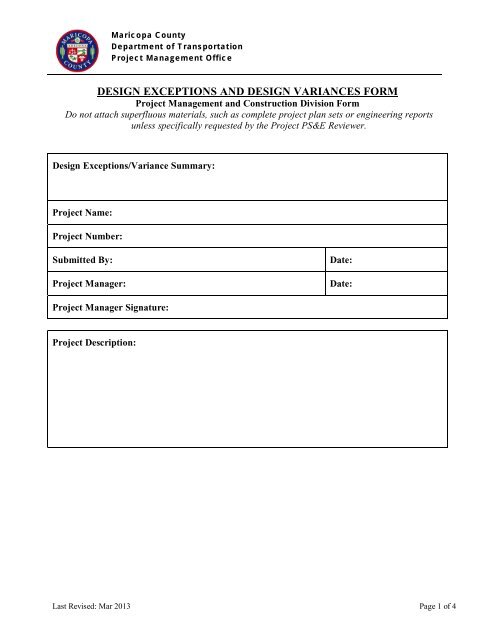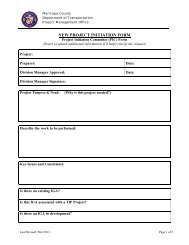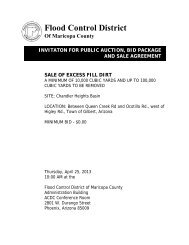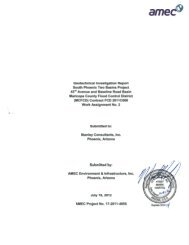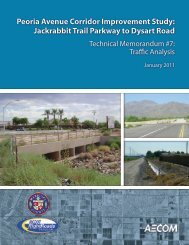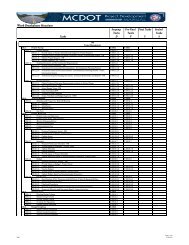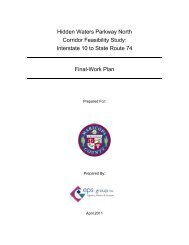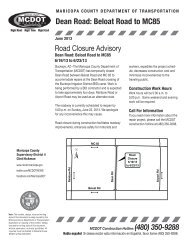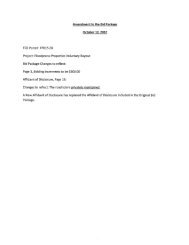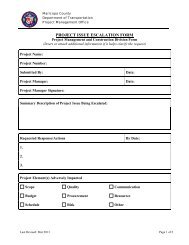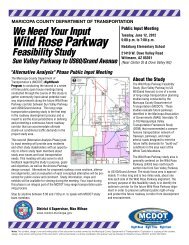design exceptions and design variances form - Maricopa County ...
design exceptions and design variances form - Maricopa County ...
design exceptions and design variances form - Maricopa County ...
Create successful ePaper yourself
Turn your PDF publications into a flip-book with our unique Google optimized e-Paper software.
<strong>Maricopa</strong> <strong>County</strong><br />
Department of Transportation<br />
Project Management Office<br />
DESIGN EXCEPTIONS AND DESIGN VARIANCES FORM<br />
Project Management <strong>and</strong> Construction Division Form<br />
Do not attach superfluous materials, such as complete project plan sets or engineering reports<br />
unless specifically requested by the Project PS&E Reviewer.<br />
Design Exceptions/Variance Summary:<br />
Project Name:<br />
Project Number:<br />
Submitted By:<br />
Project Manager:<br />
Date:<br />
Date:<br />
Project Manager Signature:<br />
Project Description:<br />
Last Revised: Mar 2013 Page 1 of 4
<strong>Maricopa</strong> <strong>County</strong><br />
Department of Transportation<br />
Project Management Office<br />
Proposed Project <strong>and</strong> Nonst<strong>and</strong>ard Features<br />
Nonst<strong>and</strong>ard Features:<br />
St<strong>and</strong>ard for Which Exception/Variance is Requested:<br />
Existing Roadway:<br />
Safety Improvements:<br />
Total Project Cost: $<br />
Reason for Requesting Exception/Variance:<br />
Added Cost to Make St<strong>and</strong>ard:<br />
Traffic Data:<br />
Last Revised: Mar 2013 Page 2 of 4
<strong>Maricopa</strong> <strong>County</strong><br />
Department of Transportation<br />
Project Management Office<br />
Accident Analysis:<br />
Incremental Improvements:<br />
Future Construction:<br />
Project Reviews, Concurrence:<br />
Attachments:<br />
Other Comments:<br />
Last Revised: Mar 2013 Page 3 of 4
<strong>Maricopa</strong> <strong>County</strong><br />
Department of Transportation<br />
Project Management Office<br />
Reviewers<br />
Traffic <strong>and</strong> Safety Engineer:<br />
Date:<br />
Signature:<br />
Construction Engineer:<br />
Date:<br />
Signature:<br />
Engineering Division Manager:<br />
Date:<br />
Signature:<br />
Transportation Planning Division Manager:<br />
Date:<br />
Signature:<br />
Project Management <strong>and</strong> Construction Division Manager:<br />
Date:<br />
Signature:<br />
Director:<br />
Date:<br />
Signature:<br />
Last Revised: Mar 2013 Page 4 of 4
MARICOPA COUNTY<br />
DEPARTMENT OF TRANSPORTATION<br />
Project Management & Construction Division<br />
PROJECT MANAGEMENT PROCEDURE<br />
BULLETIN<br />
Bulletin<br />
Title:<br />
Design Exceptions <strong>and</strong> Design<br />
Variances Form Procedure<br />
Purpose:<br />
To Outline the St<strong>and</strong>ard<br />
Procedure <strong>and</strong> Steps to Follow for<br />
Completing the Design Exception<br />
<strong>and</strong> Design Variances Form<br />
Effective Date:<br />
March 26, 2013<br />
Authorized Signature:<br />
________________________<br />
John B. Hauskins, P.E.<br />
Transportation Director<br />
Division:<br />
All<br />
Procedure Statement:<br />
All <strong>design</strong> elements which do not meet MCDOT <strong>design</strong> st<strong>and</strong>ards require a <strong>design</strong> exception. All<br />
<strong>design</strong> elements which meet MCDOT <strong>design</strong> st<strong>and</strong>ards yet do not meet recommended <strong>design</strong> values<br />
will require a <strong>design</strong> variance.<br />
Design <strong>exceptions</strong> <strong>and</strong> <strong>design</strong> <strong>variances</strong> must be submitted for review/ approval to the Project<br />
Manager, Traffic & Safety Engineer, <strong>and</strong> to the following divisions depending on whether the<br />
exception involves them: Construction Engineer, Engineering Division Manager, Transportation<br />
Planning Division Manager, Project Management <strong>and</strong> Construction Division Manager <strong>and</strong> the<br />
Director.<br />
Design <strong>exceptions</strong> <strong>and</strong> <strong>design</strong> <strong>variances</strong> are required with project types as follows:<br />
• For new construction <strong>and</strong> major reconstruction, <strong>design</strong> elements shall con<strong>form</strong> to MCDOT<br />
<strong>design</strong> st<strong>and</strong>ards, with any deviations requiring a Design exception/variance; or<br />
• For existing roadway <strong>design</strong> elements to remain, Design <strong>exceptions</strong>/<strong>variances</strong> are required for<br />
<strong>design</strong> values not meeting the MCDOT Design St<strong>and</strong>ards.<br />
Once the need for a <strong>design</strong> exception or <strong>design</strong> variance is identified, the Design Team shall:<br />
• Submit six copies of the <strong>design</strong> exception request (Signed & Sealed) to the MCDOT Project<br />
Manager with supporting documentation (i.e., typical, plan sheet, profiles, photos, etc.) <strong>and</strong><br />
Design Exceptions <strong>and</strong> Design Variances Form after a <strong>design</strong> exception/variance meeting has<br />
been held;<br />
• Evaluate the effects of the <strong>design</strong> exception/variance on the safety <strong>and</strong> operation of the<br />
facility in the documentation to justify retention of a subst<strong>and</strong>ard feature. Consider the<br />
following four issues in the analysis:<br />
o To what degree is the st<strong>and</strong>ard being reduced;<br />
o Will the exception affect other st<strong>and</strong>ards;<br />
o Are there any features being introduced to mitigate the <strong>design</strong> deviation; <strong>and</strong><br />
PMO 2013 - 1 - Last Revised: Mar 2013
o Are the <strong>design</strong> <strong>exceptions</strong> a result of implementing a cost saving measure(s) <strong>and</strong> what<br />
are the trades off?<br />
The Design Team shall make all <strong>design</strong> exception <strong>and</strong> <strong>design</strong> <strong>variances</strong> submittals to the following<br />
parties:<br />
• Project Manager;<br />
• Traffic & Safety Engineer;<br />
• Construction Engineer; <strong>and</strong><br />
• The Design Team shall keep all <strong>design</strong> exception <strong>and</strong> <strong>design</strong> variance requests <strong>and</strong> approvals<br />
in the <strong>design</strong> project file.<br />
After reviews from the Project Manager, Traffic <strong>and</strong> Safety Engineer <strong>and</strong> the Construction Engineer,<br />
the Project manager will forward the <strong>design</strong> exception <strong>and</strong> <strong>design</strong> <strong>variances</strong> submittals to the<br />
Engineering <strong>and</strong> Transportation Division Manager, Project Management <strong>and</strong> Construction Division<br />
Manager <strong>and</strong> the Director.<br />
1.0 When to Use This Form<br />
This <strong>form</strong> will be used when the need for <strong>design</strong> <strong>exceptions</strong> or <strong>variances</strong> has been identified by the<br />
Design Team.<br />
The need for <strong>design</strong> <strong>exceptions</strong> <strong>and</strong> <strong>design</strong> <strong>variances</strong> during the Final Design Phase of a project<br />
should be minimized with a thorough analysis during the Scoping Phase. It is, however, not<br />
uncommon in the refinement of <strong>design</strong> elements during the Final Design Phase <strong>and</strong> after obtaining<br />
more precise <strong>design</strong> data that the need for <strong>design</strong> <strong>exceptions</strong> or <strong>variances</strong> becomes evident. It is<br />
important that the Design Team address these changes from the scoping document early <strong>and</strong> in an<br />
expedient manner. By addressing the potential <strong>exceptions</strong> or <strong>variances</strong> in the early stage of <strong>design</strong>,<br />
impacts on schedule <strong>and</strong> project cost can be minimized. All of the controlling <strong>design</strong> elements<br />
requiring <strong>design</strong> <strong>exceptions</strong> should be refined <strong>and</strong> identified by completion of the Scoping Plans.<br />
The Pre-Final Design Phase, prior to submittal of plans for review, is the final time that a <strong>design</strong><br />
exception or <strong>design</strong> variance may be submitted for consideration. Identification of the need for <strong>design</strong><br />
<strong>exceptions</strong> <strong>and</strong> <strong>design</strong> <strong>variances</strong> after the Pre-Final Plans is an indication that the Designer has not<br />
thoroughly reviewed the <strong>design</strong> for compliance with the applicable st<strong>and</strong>ards. Only rarely <strong>and</strong> with<br />
strong justification will requests for <strong>design</strong> <strong>exceptions</strong> or <strong>design</strong> <strong>variances</strong> after the Pre-Final Design<br />
be considered. Design <strong>exceptions</strong> <strong>and</strong> <strong>design</strong> <strong>variances</strong> will not be granted based upon a lack of<br />
adequate time to make changes to meet the project schedule.<br />
2.0. Steps to Complete<br />
2.1. Proposed Project <strong>and</strong> Nonst<strong>and</strong>ard Features<br />
Project Description:<br />
Briefly describe the project; what is the proposal? Note the type of project <strong>and</strong>/or major elements of<br />
work to be done, such as safety or operational improvement, roadway widening, rehabilitation,<br />
reconstruction, etc. Provide the geographic project limits <strong>and</strong> length.<br />
Nonst<strong>and</strong>ard Features:<br />
Describe the proposed nonst<strong>and</strong>ard feature or the existing nonst<strong>and</strong>ard feature which is proposed to<br />
be maintained; if newly proposed, is the nonst<strong>and</strong>ard feature an improvement over the existing<br />
condition?<br />
PMO 2013 - 2 - Last Revised: Mar 2013
St<strong>and</strong>ard for Which Exception/Variance Is Requested:<br />
State the specific st<strong>and</strong>ards <strong>and</strong> refer to the applicable Chapter, Topic, or Index numbers of the<br />
MCDOT Roadway Design Manual or applicable AASHTO St<strong>and</strong>ards.<br />
Existing Roadway:<br />
Describe the general roadway characteristics, focusing on those features relevant to the proposed<br />
<strong>design</strong> exception, such as the width of lanes, shoulders, median, roadbed, <strong>and</strong> structures; horizontal<br />
<strong>and</strong> vertical alignment <strong>and</strong> clearances; <strong>design</strong> speed, sight distance, grade, cross slope, super elevation,<br />
etc. Is the existing roadway a part of the <strong>County</strong> primary road network?<br />
Provide a similar, but brief, description of adjacent roadway segments, highlighting existing<br />
nonst<strong>and</strong>ard features when relevant to the proposed exception.<br />
Safety Improvements:<br />
Describe proposed improvements that would qualify as safety enhancements, such as: median barrier,<br />
guardrail upgrade, flattening slopes, correcting super elevation, eliminating roadside obstructions,<br />
reducing roadway hazards, etc.<br />
Total Project Cost:<br />
Include a good summary estimate of project cost segregated by major elements, including: roadway,<br />
structures, right of way, utility relocation, environmental mitigation, etc., as needed.<br />
2.2. Reason for Requesting Exception/Variance<br />
Be thorough, but brief; justification must be as complete <strong>and</strong> convincing as possible. Reasons<br />
<strong>exceptions</strong>/<strong>variances</strong> have been granted in the past include a combination of excessive cost, right-ofway<br />
impacts <strong>and</strong>/or environmental impacts. Supportive factors have included low crash frequency,<br />
local opposition, <strong>and</strong> consistency with adjacent roadway segments.<br />
A commitment to correct a nonst<strong>and</strong>ard feature with a future project should not be made in the Fact<br />
Sheet unless absolutely necessary. If a commitment must be made, the follow-up project is to be<br />
programmed <strong>and</strong> MCDOT must have the authority to define the project's scope. Additionally, the<br />
follow-up project's status must be monitored in accordance with the procedures established by<br />
MCDOT.<br />
2.3. Added Cost to Make St<strong>and</strong>ard<br />
Summarize an estimate of the added cost above the proposed project cost which would be required to<br />
meet the <strong>design</strong> st<strong>and</strong>ard for which the exception is requested. The estimate does not have to be<br />
highly developed, but must be realistic.<br />
Also, when the Fact Sheet covers multiple nonst<strong>and</strong>ard features, provide separate cost summaries for<br />
the "st<strong>and</strong>ardization" of individual <strong>design</strong> features.<br />
2.4. Traffic Data<br />
Include both AADT's <strong>and</strong> <strong>design</strong> (peak period) hourly volumes. For 3R (i.e., rehabilitation) projects,<br />
use current year traffic. For all others, use <strong>design</strong> year traffic, usually 20 years after construction is<br />
complete. For interim projects that are to be superseded by programmed future construction, provide<br />
traffic data for both the ultimate programmed construction year <strong>and</strong> the ultimate project's <strong>design</strong> year.<br />
PMO 2013 - 3 - Last Revised: Mar 2013
2.5. Crash Analysis<br />
Traffic safety is of primary importance to both <strong>design</strong> <strong>and</strong> local programs when considering approval<br />
or rejection of <strong>design</strong> <strong>exceptions</strong>. To strengthen the justification for <strong>design</strong> <strong>exceptions</strong>, the Fact Sheet<br />
must include an analysis of crash data to identify prevalent crash types <strong>and</strong> causes, plus an evaluation<br />
of the effect of the requested <strong>design</strong> <strong>exceptions</strong> on crash types <strong>and</strong> frequencies.<br />
Summarize an analysis of how the proposed project will help alleviate identified safety problems; or as<br />
a minimum, how it will not contribute to any increase. This analysis must be based on evaluation of<br />
crash data regarding both the number <strong>and</strong> severity of crashes as well as actual versus statewide average<br />
crash rates. For <strong>design</strong> <strong>exceptions</strong> related to spot locations (i.e., nonst<strong>and</strong>ard vertical curve) on existing<br />
roadways, analyze only the crash data within the vicinity of the feature. The analysis should also<br />
examine data for high crash frequency spot locations, if any are within the proposed project limits.<br />
The data analysis should be supplemented by a review of crash diagrams covering the project area in<br />
order to enhance the underst<strong>and</strong>ing of prevalent crash types <strong>and</strong> how they relate to existing <strong>and</strong><br />
proposed Roadway <strong>design</strong> features. Provide the summary of "actual" versus "expected" crashes;<br />
however, merely stating the "actual" versus "expected" numbers is insufficient.<br />
In determining crash causes, keep in mind that although terms like "excessive speed", "inattention",<br />
"failure to yield right of way", "under the influence", etc., are perfectly valid for the law enforcement<br />
agencies, they have meaning for the roadway engineer only as they relate to the underlying roadway<br />
characteristics. Hence, the engineer must instead look for other reasons, such as: tight radius curves<br />
with inadequate super elevation, high-volume turning movements without separate turn lanes, a<br />
concentration of rear-end/side-swipe crashes in a particular lane, etc. In general, the crash<br />
concentrations detected in this manner are too small for a printout, but collectively they are the key to<br />
underst<strong>and</strong>ing the vehicle-roadway interactions that are the basic causes of crashes.<br />
2.6. Incremental Improvements<br />
Discuss other practical alternatives that are intermediate in scope <strong>and</strong> cost between the proposed<br />
project (requiring this <strong>design</strong> exception) <strong>and</strong> the full, st<strong>and</strong>ard solution.<br />
Provide enough in<strong>form</strong>ation on cost versus benefit, right of way <strong>and</strong> environmental impact, etc., to<br />
explain why none of the incremental alternatives are recommended.<br />
These alternatives should normally be investigated prior to requesting an exception.<br />
2.7. Future Construction<br />
Describe any planned future projects in the vicinity of the proposed <strong>design</strong> exception, but do not<br />
make a commitment to correct the nonst<strong>and</strong>ard <strong>design</strong> features unless absolutely necessary. If a<br />
commitment must be made, describe the follow-up project's funding source <strong>and</strong> schedule as listed in<br />
the appropriate programming documents.<br />
2.8. Project Reviews, Concurrence<br />
Note relevant project reviews by the Project Manager, plans, specifications <strong>and</strong> engineer’s estimate,<br />
PS&E Reviewers, Traffic & Safety Engineer, <strong>and</strong> Construction Engineer. Provide the date of meeting<br />
or discussion, <strong>and</strong> state the individual's concurrence with the proposed <strong>design</strong> exception.<br />
PMO 2013 - 4 - Last Revised: Mar 2013
2.9. Attachments<br />
• Provide location <strong>and</strong>/or vicinity map for the project. When the Form covers multiple<br />
<strong>exceptions</strong> at various locations, a project strip map may be provided to indicate the general<br />
location of the various <strong>design</strong> <strong>exceptions</strong>;<br />
• Provide cross sections <strong>and</strong>/or special details to clearly illustrate the proposed condition for<br />
each location that does not meet the st<strong>and</strong>ards; <strong>and</strong><br />
• Letters, resolutions, traffic study summaries, etc., which further develop or clarify the reasons<br />
discussed, may be attached.<br />
PMO 2013 - 5 - Last Revised: Mar 2013


